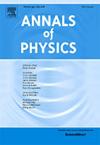规范对称与部分拉格朗日系统
IF 3
3区 物理与天体物理
Q2 PHYSICS, MULTIDISCIPLINARY
引用次数: 0
摘要
考虑一个经典场论,其运动方程遵循最小作用原理,但可容许轨迹的类别受微分方程的限制。所提出的构造的关键要素是这些附加方程的完全规范对称。轨迹的非自由变分可归结为约束轨迹的方程的无穷小规范对称变换。我们明确地推导出了根据作用的规范变化消失这一要求所推导出的方程。条件极值的方程组不是拉格朗日方程组,但它承认一个带非正则泊松括号的等效哈密顿公式。一般来说,括号是简并的。或者,限制动力学的方程可以用拉格朗日乘子加到作用中,原始变量的变化不受限制。在这种情况下,我们会得到包含拉格朗日乘数的原始变量的拉格朗日方程以及拉格朗日乘数本身的拉格朗日方程。一般来说,这两种方法是不等价的,因为与由作用的非自由变化导出的方程相比,乘数可以带来额外的自由度。我们用两个例子来说明一般方法。第一个例子是中心场中的一个粒子,它的运动轨迹受角动量守恒方程的限制。相空间获得了更多的维度,并且有一个额外的守恒量K,它负责轨迹的进动。K=0对应于通常拉格朗日动力学的轨迹。第二个例子是引力与爱因斯坦-希尔伯特作用的线性化,变化场的类别受到线性化Nordström方程的限制。这个条件极值问题可以得到线性化的Cotton重力方程。本文章由计算机程序翻译,如有差异,请以英文原文为准。
Gauge symmetry and partially Lagrangian systems
We consider a classical field theory whose equations of motion follow from the least action principle, but the class of admissible trajectories is restricted by differential equations. The key element of the proposed construction is the complete gauge symmetry of these additional equations. The unfree variation of the trajectories reduces to the infinitesimal gauge symmetry transformation of the equations restricting the trajectories. We explicitly derive the equations that follow from the requirement that this gauge variation of the action vanishes. The system of equations for conditional extrema is not a Lagrangian system as such, but it admits an equivalent Hamiltonian formulation with a non-canonical Poisson bracket. The bracket is degenerate, in general. Alternatively, the equations restricting the dynamics could be added to the action with Lagrange multipliers with unrestricted variation of the original variables. In this case, we would arrive at the Lagrangian equations for the original variables involving Lagrange multipliers and for Lagrange multipliers themselves. In general, these two methods are not equivalent because the multipliers can bring extra degrees of freedom compared to the case of equations derived by unfree variation of the action. We illustrate the general method with two examples. The first example is a particle in a central field with varying trajectories restricted by the equation of conservation of angular momentum. The phase space acquires one more dimension, and there is an extra conserved quantity which is responsible for the precession of trajectories. corresponds to the trajectories of usual Lagrangian dynamics. The second example is linearized gravity with the Einstein–Hilbert action, and the class of varying fields is restricted by the linearized Nordström equation. This conditional extrema problem is shown to lead to the linearized Cotton gravity equations.
求助全文
通过发布文献求助,成功后即可免费获取论文全文。
去求助
来源期刊

Annals of Physics
物理-物理:综合
CiteScore
5.30
自引率
3.30%
发文量
211
审稿时长
47 days
期刊介绍:
Annals of Physics presents original work in all areas of basic theoretic physics research. Ideas are developed and fully explored, and thorough treatment is given to first principles and ultimate applications. Annals of Physics emphasizes clarity and intelligibility in the articles it publishes, thus making them as accessible as possible. Readers familiar with recent developments in the field are provided with sufficient detail and background to follow the arguments and understand their significance.
The Editors of the journal cover all fields of theoretical physics. Articles published in the journal are typically longer than 20 pages.
 求助内容:
求助内容: 应助结果提醒方式:
应助结果提醒方式:


